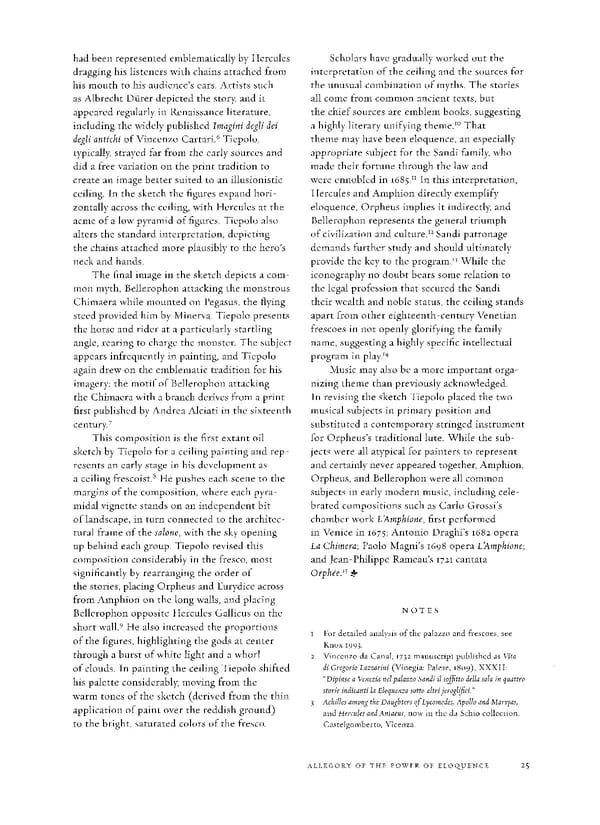had been represented emblematically by Hercules Scholars have gradually worked out the dragging his listeners with chains attached from interpretation of the ceiling and the sources for his mouth to his audience's ears. Artists such the unusual combination of myths. The stories as Albrecht Durer depicted the story and it all come from common ancient texts, but appeared regularly in Renaissance literature, the chief sources are emblem books, suggesting 10 including the widely published Imagini degli dei a highly literary unifying theme. That degli antichi of Vincenzo Cartari.6 Tiepolo, theme may have been eloquence, an especially typically strayed far from the early sources and appropriate subject for the Sandi family, who did a free variation on the print tradition to made their fortune through the law and n create an image better suited to an illusionistic were ennobled in 1685. In this interpretation, ceiling. In the sketch the figures expand hori- Hercules and Amphion directly exemplify zontally across the ceiling, with Hercules at the eloquence, Orpheus implies it indirectly, and acme of a low pyramid of figures. Tiepolo also Bellerophon represents the general triumph 12 alters the standard interpretation, depicting of civilization and culture. Sandi patronage the chains attached more plausibly to the hero's demands further study and should ultimately 13 neck and hands. provide the key to the program. While the The final image in the sketch depicts a com- iconography no doubt bears some relation to mon myth, Bellerophon attacking the monstrous the legal profession that secured the Sandi Chimaera while mounted on Pegasus, the flying their wealth and noble status, the ceiling stands steed provided him by Minerva. Tiepolo presents apart from other eighteenth-century Venetian the horse and rider at a particularly startling frescoes in not openly glorifying the family angle, rearing to charge the monster. The subject name, suggesting a highly specific intellectual appears infrequently in painting, and Tiepolo program in play14 again drew on the emblematic tradition for his Music may also be a more important orga- imagery: the motif of Bellerophon attacking nizing theme than previously acknowledged. the Chimaera with a branch derives from a print In revising the sketch Tiepolo placed the two first published by Andrea Alciati in the sixteenth musical subjects in primary position and 7 substituted a contemporary stringed instrument century This composition is the first extant oil for Orpheus's traditional lute. While the sub- sketch by Tiepolo for a ceiling painting and rep- jects were all atypical for painters to represent resents an early stage in his development as and certainly never appeared together, Amphion, 8 Orpheus, and Bellerophon were all common a ceiling frescoist. He pushes each scene to the margins of the composition, where each pyra- subjects in early modern music, including cele- midal vignette stands on an independent bit brated compositions such as Carlo Grossf s of landscape, in turn connected to the architec- chamber work L'Amphione, first performed tural frame of the salone, with the sky opening in Venice in 1675; Antonio Draghi's 1682 opera up behind each group. Tiepolo revised this La Chimera; Paolo Magni's 1698 opera L'Amphione; composition considerably in the fresco, most and Jean-Philippe Rameau's 1721 cantata significantly by rearranging the order of Orphee.^ & the stories, placing Orpheus and Eurydice across from Amphion on the long walls, and placing Bellerophon opposite Hercules Gallicus on the NOTES short wall.9 He also increased the proportions of the figures, highlighting the gods at center 1 For detailed analysis of the palazzo and frescoes, see Knox 1993. through a burst of white light and a whorl 2 Vincenzo da Canal, 1732 manuscript published as Vita of clouds. In painting the ceiling Tiepolo shifted di Gregorio Lazzarini (Vinegia: Palese, 1809), XXXII: his palette considerably, moving from the "Dipinse a Venezia nel palazzo Sandi il sojfitto della sola in quattro warm tones of the sketch (derived from the thin stork indicanti la Eloquenza sotto altrijeroglifici." 3 Achilles among the Daughters ofLycomedes, Apollo and Marsjas, application of paint over the reddish ground) and Hercules and Antaeus, now in the da Schio collection, to the bright, saturated colors of the fresco. Castelgomberto, Vicenza. ALLEGORY OF THE POWER OF ELOQJJENCE 25
 Giambattista Tiepolo: Fifteen Oil Sketches Page 25 Page 27
Giambattista Tiepolo: Fifteen Oil Sketches Page 25 Page 27